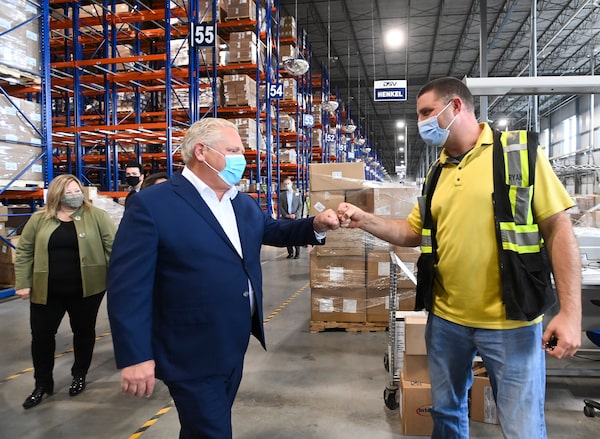
Ontario Premier Doug Ford, left, fist bumps an employee as he tours a warehouse where they ship personal protective equipment in Milton, Ont., on Sept. 30, 2020.Nathan Denette/The Canadian Press
Ontario Premier Doug Ford announced both provincewide mask rules and lower crowd limits for restaurants and other businesses in areas hit hardest by COVID-19 on Friday, but the changes failed to quiet a growing chorus of health officials calling for stricter measures.
The Premier’s moves fell short of demands from Toronto’s Medical Officer of Health, Eileen de Villa. She pleaded on Friday for the province to bring in a month-long suspension of all indoor dining, gym classes and indoor sports in her city. She also urged individuals to stay home except for essential trips – such as work, school, physical activity and shopping for food.
The Premier’s less onerous new restrictions came as Ottawa Public Health warned that the health system is “in crisis” and the Ontario Hospital Association and the Registered Nurses' Association of Ontario said that without stricter measures such as those Dr. de Villa proposed, a surge of COVID-19 patients could overwhelm the province’s hospitals.
How many coronavirus cases are there in Canada? The latest maps and charts
Critics have accused Mr. Ford of failing to adequately plan for a second wave of the virus, noting that there are lengthy lineups for COVID-19 tests despite the foreseeable demand generated by the return to school.
Earlier this week, the province’s numerical modelling experts warned it could see 1,000 cases a day by mid-October. On Friday, Ontario reported a record 732 new infections, with a growing backlog of samples that labs could not process topping 90,000.
In Quebec, health officials reported more than 1,052 new cases, a daily increase not seen since May 3. The province has already brought in tougher measures than Ontario, including restricting restaurants to takeout and delivery in Montreal, Quebec City and the Chaudière-Appalaches region, which it classifies as virus “red zones.”
Ontario’s Premier called the situation in his province serious. But Mr. Ford dismissed criticism that the government’s fall preparedness plan was rapidly being overtaken by events.
“I totally disagree with them,” he said of his critics, citing his plans to expand flu vaccinations and spend more on testing, contact tracing and health care workers. “I believe it’s a great plan. It’s the best plan in the country. … It’s so easy when you aren’t in the trenches, to sit back and be the armchair quarterback.”
The new gathering-size restrictions apply to Toronto, Peel Region and Ottawa, where the virus’s spread is concentrated. Restaurants, bars and nightclubs will be capped at 100 patrons, with just six people allowed at a table, and stricter contact tracing requirements.
The new directives emulate measures already adopted by Toronto city council, but don’t go as far. Toronto has capped restaurants and bars at 75 patrons.
The province is also capping group fitness classes at 10 participants, with just 50 people allowed in a gym. Banquet halls will also be capped at 50 people.
Although the government has previously left mask policies to municipalities or local health units, Mr. Ford said masks will now be mandatory provincewide and required in workplaces or indoor settings where physical distancing is not possible, with exceptions for people with conditions that prevent wearing a mask.
In the latest in a series of changes to testing rules that have caused confusion, Mr. Ford also announced the province’s 153 COVID-19 assessment centres, where the public can seek tests, would switch to an appointment-only model starting next week and no longer accept walk-ins as of Sunday.
The government also said the concept of 10-person “social circles,” which allowed people from different households to socialize without distancing or masks, is now “paused.”
Toronto’s mayor and Medical Officer of Health praised the province’s actions, but warned that more restrictions were needed. Mayor John Tory said the city needs to “to take this pause now, to slam the brakes on the spread of COVID-19.”
Dr. de Villa said that despite her powers under health legislation, legal advisers have told her that her recommendations “likely exceed” her authority and she needs the province to act.
“Quick action is needed now,” Dr. de Villa said. “What I don’t want is a return to a lockdown like we saw last spring. I do not believe that is necessary. My proposals are meant to prevent the conditions that would force a large-scale lockdown.”
Dr. Williams said Friday he has asked Dr. de Villa for “more evidence and data” on her calls to completely close indoor dining and sports in her city.
Ottawa Public Health said it supports of the province’s measures. But Vera Etches, the city’s Medical Officer of Health, said staff shortages are hindering testing and contact tracing, and laboratories have reached their limits. She also said that if transmission can’t be slowed now, much stricter lockdowns could become necessary.
Dr. Lawrence Loh, Medical Officer of Health for Peel Region, west of Toronto, said he welcomes the province’s new mask order for workplaces, because the majority of the region’s cases have been in factories and warehouses.
NDP Opposition Leader Andrea Horwath called for tougher measures and accused Mr. Ford of doing “the bare minimum” in order to avoid spending more on public health or supports for businesses forced to close.
With a report from Kelly Grant
Sign up for the Coronavirus Update newsletter to read the day’s essential coronavirus news, features and explainers written by Globe reporters and editors.
 Laura Stone
Laura Stone Jeff Gray
Jeff Gray Oliver Moore
Oliver Moore